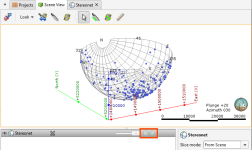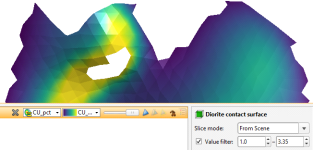What’s New in Leapfrog Geo 4.1
New features and enhancements in Leapfrog Geo version 4.1 are:
- Terminology Changes
- End Length Control on Numeric Compositing
- Stereonet in 3D
- Two-Way Structural Data Selection
- Improved Statistics on Block Models
- Ignore Duplicate Points
- Improved Copying of Section Layouts
- Batch Export of Serial Section Layouts
- Reload Polylines
- Add Columns to Structural Data, Lineations and Points
- Copying Points and Meshes
- Value Filter for Meshes
- Comments on Subfolders
- Viewing Out-of-Date Objects
- View Geological Models as a Single Object
See Updates to Previous Versions for information on changes to earlier versions of Leapfrog Geo.
Terminology Changes
The following changes to naming conventions have been made:
- The Interpolants folder has been renamed and is now the Numeric Models folder.
- Numeric, indicator and multi-domained interpolants are now referred to as “RBF interpolants”, “indicator RBF interpolants” and “multi-domained RBF interpolants”.
End Length Control on Numeric Compositing
The numeric compositing tools have new options for handling residual segments. It is now possible to add an end-segment to the previous interval, distribute the remainder equally along the hole or within the domain, or discard it, depending on the specified minimum length.
See the Numeric Composites topic for more information.
Stereonet in 3D
Visualise a stereonet in the 3D scene to aid the discovery of trends, relationships and geological structures.
Position the stereonet beside structural measurements, form surfaces and other modelling data to get a different perspective on how the structures relate to the surrounding data. For example, align the view with the intersection of two planes, along the intersection line, to discover potential fold hinges and ore-shoots.
See Displaying the Stereonet in the 3D Scene in the Stereonets topic for more information.
Two-Way Structural Data Selection
When structural data points are displayed and categorised on a stereonet, the data is also displayed in the 3D scene. Structural data can either be selected in the stereonet or in the scene. Initiate a structural selection in the stereonet and continue your selection in the scene. This flexibility maximises the stereonet-scene interaction and optimises structural data analysis.
See Using the Scene Window with the Stereonet in the Stereonets topic for more information.
Improved Statistics on Block Models
Statistics have been improved on block models and sub-blocked models. Multiple interpolant values within each lithology of a geological model can now be compared, and rows can be grouped by category or numeric. Additional statistics such as total volume and coefficient of variation have been included.
See Statistics in the Block Models topic for more information.
Ignore Duplicate Points
When fixing errors on points tables, all duplicates can be quickly ignored using a single-click. This will ignore all but the first row when multiple rows share the same coordinates.
Improved Copying of Section Layouts
The workflow for copying layouts between cross sections has been enhanced to facilitate batch copying of a layout onto multiple cross-sections at once. Layouts were copied by selecting a section and then choosing from the layouts available in the project. Now you choose which layout to copy, then select the sections to copy the layout to. See Copying Section Layouts for more information.
Batch Export of Serial Section Layouts
Export multiple layouts from a serial section. Layouts can either be exported as a single PDF file, or individual PDF, SVG, PNG and GeoTIFF files, which can then be combined into a single zip. See Batch Exporting Section Layouts for more information.
Reload Polylines
Polylines created in other Leapfrog projects or software packages can now be reloaded. Latest changes will dynamically update all dependent objects. See Reload Polyline for more information.
Add Columns to Structural Data, Lineations and Points
Imported points, structural data and lineations can now support importing of new column data. See Importing Planar Structural Data, Importing Lineations and Appending Points Data for more information.
Copying Points and Meshes
Points and meshes may now be copied within the project. This workflow is useful when testing different settings and scenarios.
Value Filter for Meshes
Value filters now work with evaluations on meshes, filtering displayed triangles according to the min / max settings. This workflow can be used to focus on an area of interest, for example, to visualise areas such as a steeply dipping slope of a pit wall or a high value area of an interpolant evaluated on a pit-shell or fault plane.
Comments on Subfolders
It is now possible to add comments to subfolders in the project tree:
Viewing Out-of-Date Objects
In previous versions of Leapfrog Geo, it has not been possible to view objects in the scene while they are in the processing queue waiting to be processed. It is now possible to view these out-of-date objects while they are queued as these objects will remain in the scene until they start being processed. Out-of-date objects waiting to be processed are displayed in the project tree with their names greyed out.
View Geological Models as a Single Object
To improve the organisation of the shape list, geological models now appear as a single object. This makes it easier to work with complex geological models. The visibility of individual volumes is controlled using the Edit Colours option:




